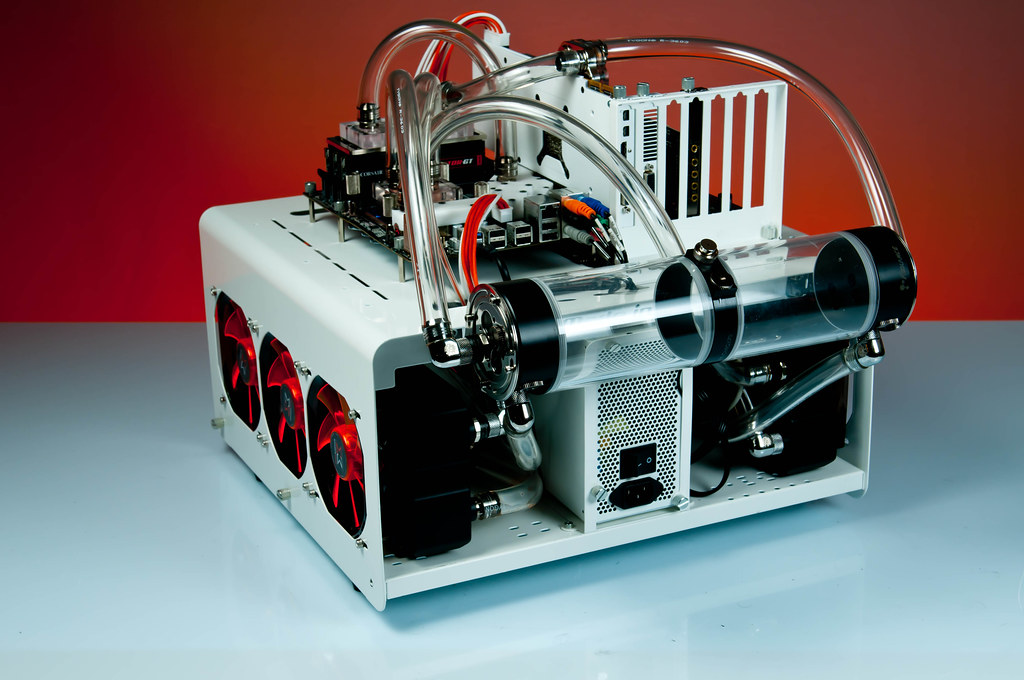
Originally Posted by
NaeKuh

1. because your still dealing with carrying capacity of water, you will get a higher delta from inlet and outlet in your system.
Gabe, if you have 3 monster class GPU's + an assortment of blocks where it crimples your flow, you cant tell me by not separating them out your not going to get better performance.
The lowest you can go is ambient... the highest you can go will be determined by how much flow you have in relationship to how many blocks are connected in a series with the overall radiator capacity.
2. By advances i mean as you get more skilled and you want customization. Are you telling us ONLY to use single loops and conform to the mac way? im sorry, but watercooling is about customization, how you build it and how you use it is totally up to the op. Telling a person the single loop is always the best and only way is blatantly wrong.
3. My system is no where near the average, its what happens after you stuck with this hobby for a very long time with a lot of resources outside of being a vendor. I can count more then a handful of systems in the worklog which would rival mine and possibly even beat it.
4. Yes i have... with everything loaded it was terrible. Were talking about 3 x 580GTX + full board block (which is given to kill flow) + cpu block. I have TOO MUCH stuff on 1 loop, if i add too many DDC's in a series my flow only goes up 1/3 for each DDC i added, and they get WORKED harder and heat up faster. Gabe have u ever attached 3 ddc's + in a series and seen how hot they run? ignoring the 35x...
Now i said single loops are ideal for the starter, who doesnt need to worry about the cache of blocks.
But not everyone is solely on just your blocks.
We use board blocks, mosfet blocks, some guys even use ram blocks.. EACH of these require flow.
To a certain point you can only get so much because water can only carry so much.
Now dont get me wrong, if your happy with your 10+ Deltas dont let me stop you... but i didnt water for that. And i sure many others will follow my shoes and strive for lower temps over bling.
If your a starter, a 10C delta might seem wow, as you get advance its dismal... you get greedy like all human nature and you strive for the less then 5C delta, even the 2C delta.
Which isnt possible in your model with EVERYTHING LOADED on the cache of blocks i have, without damaging my pumps in the future from overworkage by having too many in a series.
Im sorry i should of clarified the terminology advance...
It means as you know what each thing does in relationship to how it works, as your customizing, you plan things out accordingly so it works within the set parameters you want it to work at.
This means sometimes you will have to go outside the normal way things are done, and improvise, or innovate new ways to get the job done.
When i say advance.. it typically means, when you planned your loop, you didnt ask for help, you didnt use any resources because your brain is already a mountain of resources.
And Barf, a single loop is always a single loop if 1 component on each loop is shared regardless of how its split up.
A closed loop works on equalibirum, meaning it tries to hold constant until you exceed the maximum holding potential of water where the water temp slowly rises in a gradient form inside your loop.
Your sharing the res, that means as your pulling water from the res, your pumping it back, you will get some movement inside that second portion of the connection inside your res.. it maybe small, but its still a off parallel loop model because your sharing the res. Flow is just very dismal inside that second portion of your parallel because of the imbalance in restriction, which your second pump helped negotiate.
We never had this problem b4, GPU's didnt put out much heat (No one really SLI'd and when you sli'd it ended at 2 and Xfire was even rarer) and cpu's didnt, unless u were on a kentsfield under constant load all the time... there was no board blocks til Bitspower, Bei and I started innovating, so there was no true flow killers out there (Except the EK supreme).
Gpu blocks were just solid slabs of copper with channels (not micro channels which are more efficient) and now have they have water channels on the vrm's so they pick up even more heat.
We didnt have these options, but we do now... things add up, nothing in the world is for free, and everything comes at a cost unless you pay for the cost. <-- this is the rule of thermo.






 *
*


 Reply With Quote
Reply With Quote








Bookmarks